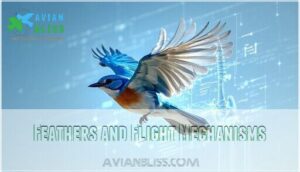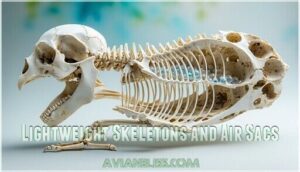This site is supported by our readers. We may earn a commission, at no cost to you, if you purchase through links.

While you might think "are birds mammals" because both groups are warm-blooded and care for their young, the differences tell a different story.
Birds have feathers instead of fur, lay hard-shelled eggs rather than giving live birth, and possess hollow bones that make flight possible.
Mammals, on the other hand, have hair or fur, produce milk through mammary glands, and typically birth live young.
Think of it this way: a penguin that can’t fly is still a bird, while a bat that soars remains a mammal.
The classification depends on these fundamental biological traits that reveal some fascinating evolutionary secrets.
Table Of Contents
- Key Takeaways
- Birds Classification Basics
- Are Birds Mammals?
- Bird Characteristics and Traits
- Mammalian Characteristics Defined
- Differences Between Birds and Mammals
- Frequently Asked Questions (FAQs)
- Are birds considered mammals?
- What is a bird classified as?
- Is a bird a reptile or mammal?
- What animals are not mammals?
- Are birds considered to be mammals?
- Are there any birds that are classified as mammals?
- How are birds different from mammals?
- What are the differences between mammals and birds?
- Is A bird A Amphibian or a mammal?
- How do birds and mammals breathe differently?
- Conclusion
Key Takeaways
- You’ll find that birds aren’t mammals – they’re classified as their own distinct group called Aves, with feathers instead of fur and beaks instead of teeth.
- You can easily tell birds and mammals apart by their reproduction methods: birds lay hard-shelled eggs while mammals typically give birth to live young and produce milk through mammary glands.
- You’ll notice birds have hollow bones filled with air sacs for efficient flight, while mammals have dense, solid bones filled with marrow that’s perfect for supporting weight on land.
- You’ll discover both groups are warm-blooded vertebrates with four-chambered hearts, but their respiratory systems work differently – birds use one-way airflow through air sacs while mammals expand and contract their lungs.
Birds Classification Basics
When you look at a robin or eagle, you’re observing a member of the class Aves, which scientists separate from mammals based on distinct physical traits and biological processes.
Understanding these classification basics will help you recognize why that feathered friend outside your window belongs to an entirely different group than your pet dog or cat.
Feathers and Flight Characteristics
Every bird’s feather structure works like nature’s engineering marvel, creating the perfect tool for flight.
Feathers aren’t just pretty decorations—they’re sophisticated flight machines that put human aviation to shame.
You’ll notice flight muscles make up nearly 30% of a bird’s body weight, powering those incredible wing shapes that generate aerodynamic lift.
These amazing flight adaptations in avian biology showcase how bird anatomy evolved specifically for soaring through skies with remarkable efficiency.
Beaks and Diets Variations
Birds showcase incredible beak shapes that reveal their diet types and feeding behaviors.
You’ll find seed eaters sporting thick, sturdy beaks for cracking tough shells, while insectivores possess thin, pointed bills perfect for snatching bugs.
This diversity in avian biology helps scientists understand bird classification within vertebrate species, distinguishing them from mammal characteristics through these specialized feeding adaptations.
Exploring different beak adaptations for birds can further illustrate these dietary specializations.
Laying Hard-Shelled Eggs Traits
Unlike mammals that give birth to live young, you’ll find birds producing eggs with remarkable calcium carbonate shells.
These protective barriers maintain perfect incubation temperature while allowing oxygen exchange through eggshell porosity.
Inside, embryo development unfolds over weeks as parent birds demonstrate dedicated nesting behaviors. This fundamental difference in reproduction clearly separates bird vs mammal characteristics, defining what makes birds unique.
Some birds also experience hormonal changes that signal readiness to lay eggs, which is a key aspect of their reproduction and overall biological characteristics.
Lightweight Skeletons Advantages
A bird’s hollow bones aren’t just nature’s weight reduction trick—they’re engineering marvels that put aircraft designers to shame.
These lightweight skeletons deliver maximum bone strength while cutting dead weight, creating perfect muscle attachment points for flight efficiency.
Unlike mammals with solid bones, birds achieve aerodynamic design through this brilliant vertebrate adaptation that makes soaring possible.
Air Sacs and Oxygen Exchange Mechanisms
Beyond their hollow bones, birds possess an incredibly efficient respiratory system that puts mammals to shame.
You’ll find that air sacs connected to their lungs create a one-way airflow system, ensuring fresh oxygen constantly reaches their tissues.
This avian respiration efficiency enables high-altitude flight and sustained energy output.
Here’s how their gas exchange works:
- Air sacs store oxygen-rich air and pump it through lungs continuously
- One-way airflow prevents stale air from mixing with fresh oxygen
- Higher oxygen absorption rate compared to mammalian breathing patterns
- Efficient respiratory system supports intense metabolic demands during flight
- Air sac function allows birds to maintain peak performance at extreme altitudes
Are Birds Mammals?
You might wonder if that robin in your backyard shares more with your pet cat than you’d expect, but birds aren’t mammals despite some surprising similarities.
While both groups are warm-blooded vertebrates with four-chambered hearts, birds have feathers and lay eggs, whereas mammals have fur and produce milk for their young. Birds have feathers and lay eggs, whereas mammals have fur and produce milk for their young.
Definition of Mammals and Birds
Scientists classify warm-blooded vertebrates into distinct groups based on key traits.
Mammals are endothermic animals with hair that produce milk through lactation, while birds are warmblooded animals with feathers that lay eggs.
Both share four-chambered hearts and endothermic traits, but their animal classification depends on reproductive methods and body coverings that define each vertebrate group.
Key Differences Between Birds and Mammals
When comparing these warmblooded animals, you’ll notice fundamental differences in animal characteristics.
Birds sport feathers while mammals have fur, showcasing distinct body coverings. Reproductive strategies differ dramatically—birds lay hard-shelled eggs versus mammals giving live birth.
Skeletal adaptations reveal lightweight, hollow bones in birds contrasting with denser mammalian structures.
These vertebrate respiratory systems and thermoregulation methods also vary substantially between species.
Similarities Between Birds and Mammals
Despite their differences, you’ll find surprising connections between these warmblooded vertebrates.
Both birds and mammals share four-chambered hearts, enabling efficient circulation for their active lifestyles.
Warm-bloodedness allows both groups to thrive in diverse climates, their endoskeletons provide structural support, while impressive intelligence levels help them adapt.
Most importantly, both demonstrate remarkable parental care, nurturing their young through vulnerable early stages.
Bird Characteristics and Traits
You’ll discover that birds possess remarkable traits that make them perfectly adapted for their aerial lifestyle, from their lightweight hollow bones to their incredibly efficient respiratory systems.
Understanding these unique characteristics will help you see why birds can’t be classified as mammals, despite sharing some surprising similarities like being warm-blooded vertebrates.
They have features that distinguish them clearly, making their classification distinct, which is an important aspect of understanding their biology and aerial lifestyle.
Feathers and Flight Mechanisms
Feathers aren’t just pretty decorations—they’re engineering marvels that make flight possible for warmblooded vertebrates.
These complex structures work with specialized adaptations to keep birds airborne:
- Feather Structure creates lift through interlocking barbs
- Flight Aerodynamics optimize air flow over wings
- Bone Pneumatization reduces weight with hollow bones
- Muscle Adaptations power wingbeats efficiently
- Avian Respiration delivers oxygen during flight
Beaks and Diets Specializations
When you examine bird species across different habitats, you’ll notice their beaks reveal fascinating dietary adaptations.
Each vertebrate has evolved specific beak morphology that matches their feeding strategies perfectly. Ostriches use broad, flat beaks for omnivorous diets, while hummingbirds sport needle-like bills for nectar extraction.
This niche partitioning allows diverse wildlife to coexist without competing for identical food sources. Bird enthusiasts can even find specialized beak toys designed to promote beak health.
| Beak Type | Diet Specialization | Example Species |
|---|---|---|
| Hooked/Curved | Tearing meat, fish | Eagles, hawks, pelicans |
| Needle-like | Nectar feeding | Hummingbirds, sunbirds |
| Seed-cracking | Hard seeds, nuts | Cardinals, finches |
| Filter-feeding | Small organisms, plankton | Flamingos, ducks |
Laying Hard-Shelled Eggs Processes
You’ll find that bird reproduction follows a fascinating sequence from yolk deposition to hatching.
The eggshell formation process creates calcium carbonate shells that protect developing chicks, while albumen production provides essential nutrients.
This reproductive strategy distinguishes birds from mammals in animal classification:
- Oviposition process involves laying eggs externally
- Incubation requirements vary among bird species
- Hard shells enable terrestrial reproduction
During this process, it’s vital to monitor for signs of calcium deficiency risks to ensure a successful outcome, which is crucial for animal classification and understanding calcium carbonate shells.
Lightweight Skeletons and Air Sacs
You’ll find that bird bones are surprisingly hollow, a process called bone pneumatization that creates lightweight yet strong structures.
These hollow spaces connect to air sacs throughout their bodies, which work alongside their lungs for efficient gas exchange.
This clever design reduces weight by up to 20% while maintaining skeletal strength, making flight possible for creatures their size with efficient gas exchange and a strong yet lightweight structure due to pneumatization.
Respiratory Systems and Oxygen Exchange
Birds possess the most efficient respiratory system in the animal kingdom, unlike mammals that rely on simple lung expansion.
Their unique setup guarantees continuous oxygen flow through specialized air sacs and hollow bones.
Here’s how avian lung efficiency surpasses other vertebrates:
- One-way airflow prevents stale air mixing with fresh oxygen
- Dual breathing cycles maintain constant gas exchange during flight
- Altitude oxygen adaptation supports high-elevation soaring
Mammalian Characteristics Defined
You’ll recognize mammals by their defining traits that set them apart from all other animal groups, including birds.
These warm-blooded vertebrates possess hair or fur, produce milk through mammary glands, and typically give birth to live young rather than laying eggs, which are key characteristics that distinguish them as mammals.
Fur or Hair and Body Covering Types
You’ll notice mammals sport hair or fur as their signature body covering, while birds rock feathers instead.
Mammalian traits include diverse hair types serving multiple purposes – from thick fur insulation in polar bears to fine whiskers for sensing.
Unlike scale types found in reptiles or skin respiration in amphibians, fur functions primarily for temperature control and protection in mammals.
Mammary Glands and Nursing Functions
Mammals possess mammary glands that produce milk through complex lactation processes driven by specific hormones.
You’ll find these specialized structures absent in birds, which rely on regurgitated food instead.
Milk composition varies among mammalian species, providing essential nutrients adapted to each offspring’s needs.
This nursing behavior creates strong mother-infant bonds while delivering antibodies for immune protection that birds simply can’t replicate.
Live Births and Reproductive Traits Variations
Beyond milk production, you’ll find that mammalian reproductive strategies showcase incredible diversity across the animal kingdom.
Most mammals give birth to live young, but biological classification reveals fascinating variations:
- Placental Development: Elephants experience two-year gestation length with complex parental care
- Marsupial Pouches: Kangaroos birth tiny offspring that complete development externally
- Monotreme Reproduction: Platypuses uniquely lay eggs among vertebrate animals
Birds, however, exhibit oviparous reproduction with hard-shelled eggs.
Internal Bones and Skeletal Structure Types
When you examine mammalian skeletons, you’ll find dense bones filled with marrow that produces blood cells.
The Ossification Process creates solid structures perfect for supporting body weight and muscle attachment.
Unlike birds with their hollow, air-filled bones, mammalian Bone Composition prioritizes strength over lightness, reflecting different evolutionary pressures in vertebrate anatomy.
| Skeletal Feature | Mammalian Structure |
|---|---|
| Bone Density | Dense, solid cortical bone |
| Marrow Function | Blood cell production center |
| Anatomical Features | Heavy, supportive framework |
Teeth and Dental Adaptations Examples
Looking at mammalian mouths reveals fascinating connections between tooth morphology and diet correlation.
You’ll find that dental evolution shaped species identification through specialized teeth – sharp canines for carnivores, flat molars for herbivores.
Enamel composition varies dramatically across the classification system, while jaw mechanics determine feeding efficiency.
This animal taxonomy feature distinguishes mammals from birds, who lack teeth entirely and rely on beaks instead, highlighting the unique aspect of dental evolution.
Differences Between Birds and Mammals
When you compare birds and mammals side by side, you’ll notice they’re as different as a feathered friend and your furry pet.
You can easily tell them apart by looking at their body coverings, how they’ve babies, and the unique ways they’ve adapted to survive in their environments.
Reproductive Strategies Comparisons
In the context of reproduction, you’ll find these vertebrate groups take completely different approaches.
Birds commit to egg laying with hard shells, while mammals typically embrace live birth after extended gestation periods.
Here’s how their reproductive strategies differ:
- Egg development: Birds incubate externally; mammals develop internally
- Parental investment: Both show extensive parental care through different methods
- Mating rituals: Species-specific courtship behaviors vary dramatically between groups
Body Covering and Insulation Types
When comparing body coverings, you’ll notice striking contrasts between birds and mammals.
Birds rely on feather insulation to regulate body temperature, while mammals use fur density or hair for warmth.
Marine mammals add blubber thickness for extra insulation.
Unlike birds’ waterproof feathers, mammalian fur traps air pockets, creating efficient thermal barriers that keep body heat from escaping.
Skeletal Adaptations and Weight Differences
Bird skeletons are nature’s engineering marvels compared to mammals. Their hollow bones achieve remarkable weight reduction while maintaining skeletal strength – a perfect flight adaptation.
Meanwhile, mammal bones prioritize bone density for ground-based activities. This difference in animal classification reflects millions of years of evolutionary specialization.
Birds also have specialized beaks suited for their diets.
- Bird bones contain air spaces that reduce weight by up to 20% compared to solid mammal bones
- A flying pigeon’s entire skeleton weighs less than its feathers – talk about efficient design
- Mammal bones are dense and heavy, built like reinforced concrete for supporting body weight on land
- Bird wing bones are reinforced where stress is highest, like architectural beams in a bridge
Respiratory Systems and Oxygen Exchange Variations
When breathing, you’ll notice birds and mammals use totally different systems.
Birds possess avian air sacs that create one-way airflow through their lungs, maximizing gas exchange efficiency.
Meanwhile, mammals rely on a mammalian diaphragm that expands and contracts lungs bidirectionally.
These respiratory adaptations give birds superior oxygen delivery during flight, while mammalian respiration works perfectly for ground-based activities.
Thermoregulation and Environmental Adaptations
How do birds and mammals stay cozy in harsh climates? Both are endotherms that regulate body temperature, but they’ve mastered different survival tricks:
- Feather Insulation – Birds trap air between layers for warmth
- Hair Insulation – Mammals use fur density for temperature control
- Metabolic Rates – Birds burn energy faster than most mammals
- Migration Patterns – Birds escape cold; mammals often hibernate
- Habitat Preferences – Each group’s climate challenges shape unique adaptations.
Birds utilize various physiological adaptations for survival.
Frequently Asked Questions (FAQs)
Are birds considered mammals?
No, you can’t classify birds as mammals.
They’re completely different animal classes.
Birds have feathers, lay eggs, and possess beaks, while mammals have fur, give birth to live young, and produce milk.
What is a bird classified as?
You’ll find that these feathered creatures belong to the class Aves, making them vertebrates with warm blood, four-chambered hearts, and unique respiratory systems.
They’re definitely not mammals, despite sharing some traits!
Is a bird a reptile or mammal?
Like sorting puzzle pieces, you’ll discover birds aren’t reptiles or mammals at all.
They’re their own unique class of vertebrates with feathers, beaks, and wings, making them perfectly distinct from their scaly or furry cousins.
What animals are not mammals?
You’ll encounter countless non-mammals in nature.
Reptiles like snakes and lizards, amphibians such as frogs, birds including eagles and penguins, fish, insects, spiders, and jellyfish all lack the defining mammalian traits of fur and milk production.
Are birds considered to be mammals?
Birds aren’t mammals – they’re their own class of vertebrates.
You’ll notice birds have feathers, lay eggs, and lack mammary glands.
Mammals have fur, give birth to live young, and produce milk for their offspring.
Are there any birds that are classified as mammals?
Absolutely amazing answer: No birds are classified as mammals.
You’ll find birds belong to class Aves while mammals belong to class Mammalia.
These classifications remain completely separate in scientific taxonomy despite some superficial similarities.
How are birds different from mammals?
You’ll notice key differences between these two groups.
Birds have feathers and beaks, while mammals sport fur and produce milk.
Birds lay eggs, but most mammals give birth to live young instead.
What are the differences between mammals and birds?
You’ll find mammals have fur or hair and produce milk for their young, while birds sport feathers and lay eggs.
Mammals give live birth (mostly), but birds hatch from shells—nature’s different approaches to parenting.
Is A bird A Amphibian or a mammal?
Neither amphibian nor mammal, you’ll discover that birds form their own distinct class of vertebrates.
They’re warm-blooded creatures with feathers, beaks, and wings – completely separate from both cold-blooded amphibians and milk-producing mammals, which makes them a distinct class.
How do birds and mammals breathe differently?
You’ll notice birds have air sacs that create a continuous airflow through their lungs, while you breathe using your diaphragm to expand and contract your lungs in a back-and-forth pattern.
Conclusion
Ironically, while you’ve been flapping around this question, the answer’s been crystal clear all along.
No, are birds mammals isn’t a trick question – birds belong to their own distinct class called Aves.
You’ve discovered that feathers, hollow bones, and egg-laying separate birds from their furry, milk-producing mammalian cousins.
Next time someone asks if your pet parakeet’s a mammal, you’ll confidently explain why it’s proudly wearing its bird badge instead, knowing it’s not a mammal.














